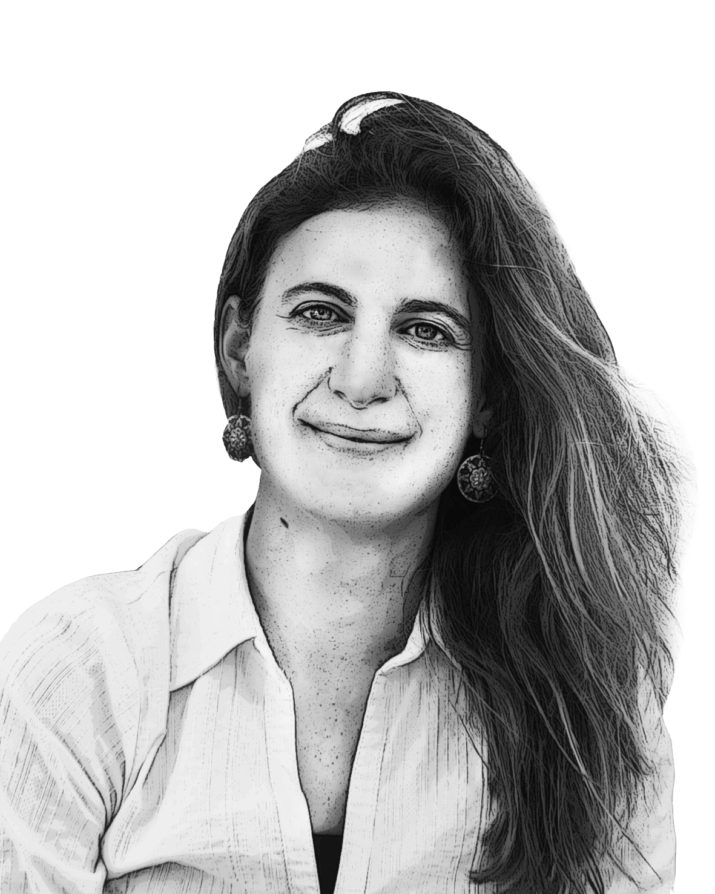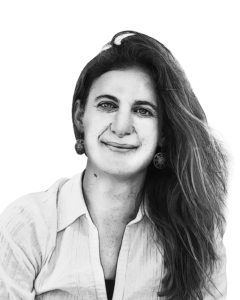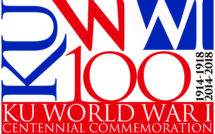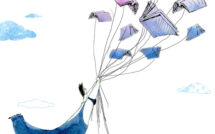

This is part of our special feature Memory and the Politics of the Past: New Research and Innovation.
As an assistant professor in European studies at Maastricht University (NL), Aline Sierp’s research focuses on collective memory, questions of identity, and European integration. Currently, she is focusing on what the European Union is doing in terms of memory politics, and she is particularly interested in how contemporary memory discourse intersects with questions of European integration. More specifically, she is looking at the division of Europe—its eastern and western blocks—and the fissures, political clashes, and misunderstandings that occur when these narratives are bound together under the integrative banner of the European Union. On January 24, Aline attended the symposium Under Glass: Museums and the Memory of Nazi Fascism, the Holocaust, and WWII: Toward a Shared European History? where she presented a paper titled “A Contested Latecomer, the Munich Documentation Center for the History of National Socialism.” I had the opportunity to attend the symposium and the privilege to interview Aline. I found that not only is Aline’s work on memory fascinating, it is absolutely relevant to our present, and even more so to our future.
–Lillian Klein for EuropeNow
EuropeNow What inspired you to study collective historical memory?
Aline Sierp Well, I think that part of it has to do with the fact that I am German. When you grow up in Germany you are constantly surrounded by this history. You cannot escape it. And I’ve always been interested in that. For my bachelors and masters I studied European studies, not necessarily with a focus on WWII or memory issues, but I did write my master’s thesis on coming to terms in post-war Italy and Germany—I did part of my masters in Italy and I noticed differences compared to Germany even though both nations came out of totalitarian regimes after WWII. And, theoretically speaking, both of them had a very similar starting point. But ultimately when you look at their development over time, I was struck by the differences in how they each moved forward.
EuropeNow What is your definition of historical memory? How does it relate to, say, museums?
Aline Sierp The term “collective memory” was first invented by Maurice Halbwachs, a French sociologist, who came up with the idea that there’s more than just individual memory. He said, we cannot possibly remember just by ourselves. Maurice Halbwachs’ definition of collective memory is a bit vague and hazy. Others have created distinctions within this idea of collective memory. From there, it depends which scholar you follow. I have very much adopted Assmann’s distinction. Jan and Aleida Assmann came up with the idea that, fundamentally, there are three levels. First, the individual—autobiographical—memory; this is what you remember. Then you have social memory; this is what groups remember. Groups tend to exchange their own memories and make a selection of the ones they want to keep. This process is based on communication, which is why it is also often called communicative memory. The third level is cultural memory; this is memory that is often transmitted by material carriers—museums, memorials, it could be books or institutions, but it’s not necessarily connected to the people who lived it. Cultural memory usually appears after a period of eighty to one hundred years.
EuropeNow Can you give us an example of this progression, the evolution, of historical memory? How are we seeing this now?
My argument is this: when it comes to WWII and the Holocaust, we are exactly at this eighty to one hundred year watershed; exactly when the last eyewitnesses are dying and we no longer have access to the people who lived through these times. It starts to turn into cultural memory, transmitted by institutions, by material carriers, which means there is a selection process happening of the memories we will pass on. That’s why there is so much talk about WWII and the Holocaust at the moment, everyone is saying, particularly politicians, that we have to decide now what we will transmit to the future generations who will never be able to see or speak to the people who’ve lived through this period of history.
EuropeNow How do you describe the difference between a museum and a memorial site?
Aline Sierp A memorial site is usually an authentic site—a place where things have happened. You can have museums in memorial sites. For example, the Dachau concentration camp memorial site, where I worked before joining the University of Maastricht, has a museum but at the same time it is on the premises of a former concentration camp. Also, the museum in Munich, which I discussed in my presentation, stands on historical ground—it’s built on the exact same place where the Braune Haus stood; the party headquarters of the NSDAP. But the museum and learning center is a new, modern building, so in that sense it’s a little bit of a hybrid. It’s not really a memorial site, but it’s very closely connected to the historical district surrounding it. The architect tried to design a building that creates a stylistic break with its surroundings. That’s why they have windows stretching from the floor up to the ceiling: when you are inside, you don’t lose sight of the surrounding historical buildings outside. They create breaks in the façade. When people are inside they can constantly look outside.

EuropeNow Oh wow, it is very modern. It does create a disruption in the surrounding architecture.
Aline Sierp There are many perpetrator sites that potentially could be sites of NS/fascist pilgrimages, and a large part of wanting to create this visible break with the surroundings, is to deny that option. Looking at it, no one would go to the Munich Documentation Center, and say, “Ooh, this is where the Braune Haus stood and that’s why we come here.” No. It is not the former NSDAP headquarters anymore. It is a learning center.
To give another example: the Dachau concentration camp was built in 1933, right after Hitler took power. It was not only the very first concentration camp, but there was also a training camp for the SS. Most SS leaders, who then ran other concentration camps, were trained in Dachau. And the training camp area is still there. Now, the former concentration camp has turned into a memorial site; there’s a museum, you can visit the reconstructed barracks, you can visit the crematorium. And where the training camp was, they put the Bavarian Riot Police.
EuropeNow That’s interesting. What has the reaction been to that decision?
Aline Sierp Some people might say, “That’s a strange continuity. How can you possibly put the police in a place where the SS was trained?” But one of the reasons the Bavarian Riot Police gives if you ask them about this, is that they do not want this site to become a destination for neo-Nazis. We, the administration at the museum and memorial site, were in close contact with the Riot Police, and they always underlined that their presence at this site showed that there is a clear break with that history.
EuropeNow How and why does “place” matter in terms of memorial sites? Is it important?
Aline Sierp I think it is. Simply because it does make a difference to people if it’s an authentic site or not. But authentic sites have problems as well, because places can have a very emotional element to them. The Munich Documentation Center tried to limit this emotional component by not displaying any objects. Most museums will have a huge display of objects, which can give room to auratisation—charging the objects with meaning, and giving them an aura of glorification. They tried to avoid this because it is a perpetrator site.
EuropeNow Objects, especially from something like the Holocaust, can be so emotive and therefore blinding. Do memorial sites hold an important place, in that they do evoke that kind of emotion?
Aline Sierp If you go to a memorial site that is on a former concentration camp, and you look at the crematoria, you cannot avoid the intense emotional impact of it. Until the 1980s there was the tendency to have many objects, and huge, blown-up pictures. If you look at museums, exhibitions now, they don’t have that anymore. Because it shocks. Because people do have very strong emotional reactions. Emotions can open a channel, but they can also block channels—block rationalization, reflection.
EuropeNow Okay great, that was my follow up: how and what, does it inhibit? What is the goal to making presentations of this particular subject matter more objective, and rely less on emotion for engagement?
Aline Sierp Well, I think the attempt is to foster reflection, and to focus on the kind of dynamics that led to WWII, which is more difficult if you are overwhelmed emotionally.
I’ve lived abroad for so long and seen so many different approaches to how to manage this. When I was at the Dachau concentration camp memorial site I was responsible for the international sector, and what I quickly had to learn was that for some nations it is very strange to not have this emotional element. We should not think that any template works for everyone. To give an example: the often very sober, German way of presenting the story, might not work for an Italian. I have the impression, and again this is my personal opinion, that many of the German memorial sites went to an extreme, limiting this emotional element as much as possible.
EuropeNow Can you tell me more about the Munich Documentation Center’s display design? Without objects, what do they have, what is the presentation?
Aline Sierp The display consists mainly of documents and pictures of the time. There are also many interactive media installations.
Inside the building there are displays with short films, but what is much more interesting is what’s happening outside: There are big media installations; monitors that have disappeared partly into the ground, so they look like sunken tombstones. These monitors show small films. The museum has selected ten key documents of the NS period, and added about two thousand pictures—one picture representing one word in the document. The sequence creates a little film. Some of the associations created between picture and word are a little unusual so it takes some time for visitors to understand. It’s almost like a guessing game: the visitor is asked to follow the associations and understand what they mean.
EuropeNow I would love that—it sounds so engaging.
Aline Sierp Many people stop and then they try to understand what this is about—some people have a lot of fun trying to guess, some don’t understand and turn away immediately. The films play with the illusion of perception. Similar to the building itself. The main focus of the museum is the question “What does the NS history have to do with me?” It is targeting an individual level of reflection and it is in that way, breaking out of the usual model of NS museums that are trying to explain the period between 1933 and 1945.
EuropeNow Why did it take so long [70 years] for Munich to finally open a museum concerning this material? What kind of hurdles [bureaucratic, political] are experienced in the making of museums—this one in particular?
Aline Sierp You would not expect this in Germany. And you would not expect this in Munich, which was at the center of the NSDAP development.
EuropeNow Right, because Germany is upheld as a society and culture that has been actively addressing this past, and held up as an ideal of how a society should deal with its past…and yet it took so long for this educational center to open.
Aline Sierp Munich was called the capital of amnesia, because it took the city very long to put up commemoration plaques and memorials dedicated to the victims of the Third Reich. I think the only really active public engagement was in Dachau, which is twenty kilometers away from Munich. It almost looked as if, because the city council was engaged over there, it thought it did not have to get involved in any activities concerning coming to terms with Munich’s dark history.
And I think part of it—this is my guess—is the fact that it was perceived as disturbing to think more deeply about the reasons why Munich provided such an important seeding ground for the NSDAP. I think it shook the self-understanding of the city. When you look at how Munich presents, and always has presented itself, you realize that a key pillar of its identity has always been its openness, its friendliness. If you talk to people from Munich they will say, “yes we are very friendly, yes we are very tolerant.” Munich’s dark history and the knowledge that the NSDAP took its first steps there, and that Hitler would have probably never gotten as far as he did without the support that he enjoyed in Munich, clashes with the self-image, the self-identity, that the city has given itself. I think this is part of the reason why it was so hard for the city to publicly acknowledge this history and to critically reflect on it.
When it comes to the concrete difficulties faced when creating this museum—and this has happened with many museums—most problems are related to financing. It’s obviously an expensive project, and the question was who was going to pay for that? The costs were eventually divided between the city council, the free state of Bavaria, and the federal state. It took some time before they found a solution there.
EuropeNow You’re co-chair of the Council for European Studies’ Transnational Memory and Identity in Europe Research Network, how does the research network contribute to your research?
Aline Sierp The CES Network is mainly about networking. Its aim is to allow people to get to know each other, to find partners they could potentially collaborate with, to meet at conferences, to exchange ideas about research.
Our Research Network does have a very active list-serve, which works really well. We have almost 300 members, and we know that people do read what we send around. It’s not the only mailing list on memory, but it seems to be one of the ones that is most active.
EuropeNow We’ve recently launched a new educational platform called EuropeNow Campus, designed to be a place where educators can share innovative teaching methods, useful interdisciplinary tools, and syllabi that engage students and functionally connect classroom learning and real-world impact. Are there any methods you can think of that have worked particularly well? How do we get younger people to care about something that they might not think is entirely relevant to them or their lives?
Aline Sierp At Dachau—where I taught the educators, so this was meta-teaching if you will—one of the questions we always asked ourselves was the one you have just asked, “how do we get the young generation interested in a history that is so far away for them?”
Very often, they no longer have grandparents that can tell them about this event.
They feel that WWII and the Holocaust is something that happened a long time ago and is not going to happen again. And they wonder: why do we have to learn about this?
What worked in the Dachau context was to not concentrate on the historical events as such, because they are distant for them, but to concentrate instead on the mechanisms that led to these events, because they are still present in our contemporary society. Young students all have seen people being excluded from groups, they’ve all seen elements of racism xenophobia etc., they’ve very often experienced themselves how it feels when you are suddenly excluded from a group, especially in school. Children can be cruel sometimes; most of them have experienced exclusion. It is an experience they can relate to—that’s when they suddenly understand and become interested in history. And that’s when you can also make connections to the present: What do they see around them? Why do they have to be vigilant?
EuropeNow Yeah, I feel some of that vigilance has been lost. Listening to Trump’s inauguration speech last week—the rhetoric was frighteningly nationalistic. Those parallels are overwhelming—I still haven’t wrapped my mind around it—is it that people choose not to look at that, not to include it in the cultural memory of it?
Aline Sierp Yes. It’s not only that things are left out, it’s that things that used to be unacceptable to say, suddenly have become acceptable. Hearing this rhetoric has become almost normal. I think that is what’s worrying.
EuropeNow That they are acceptable, seems to be a direct result of us being a full generation away from this, and we’ve had such a long period of relative peace—nothing like WWII—that it feels easier to assume that kind of language when you don’t fully understand, on an individual, experiential level, what it means.
Aline Sierp Absolutely, and that’s a big danger we are experiencing at the moment; that people don’t understand the connections anymore. We should not forget that Hitler came to power in a democratic way. He was elected. That’s what we have to keep in mind.
Some things developed slowly. The annihilation of the Jews was not necessarily planned from the very beginning. It’s often forgotten that this was a step after step process, so we have to be careful. We have to look at these initial steps if we want to prevent the repetition of history, otherwise it will soon be too late.
Aline Sierp is Assistant Professor in European Studies at Maastricht University (NL). She holds a PhD in Comparative European Politics and History from the University of Siena (IT). Her research interests cover collective memory, questions of identity, and European integration. Before joining the University of Maastricht, Sierp worked as researcher at the Dachau Concentration Camp Memorial Site (DE). She has published widely on memory and identity issues and is the author of History, Memory and Transeuropean Identity: Unifying Divisions (Routledge, 2014).
Lillian Klein is the programs coordinator at the Council for European Studies. She holds a B.A. in literature with a minor in religious studies from Barnard College, as well as an M.F.A. in fiction from Columbia University. Previously, Lillian assisted in the Memberships, Programs, and Awards Department at PEN America Center. She also served as a teaching fellow at Paris American Academy’s writing program for two consecutive summers.
Photo: Aline Sierp, Private
Photo: NS-Dokumentationszentrum München, March 2015 | Photo: Jens Weber
Published on April 4, 2017.




